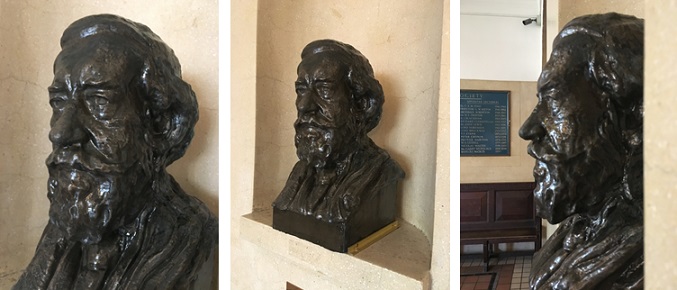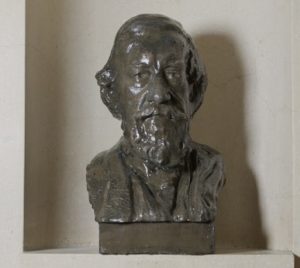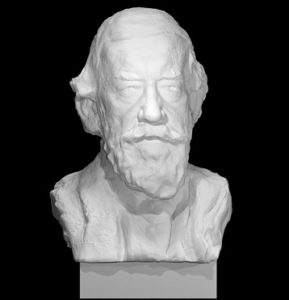Heritage, Culture, Knowledge (some missing!) and Cutting-Edge Technology by Dr. Jim Walsh
In 1929, Conway Hall was unveiled with a niche in the foyer, this niche was designed to display a revered piece of artwork; a bronze bust of Dr Moncure Conway (1832 – 1907), celebrated writer, abolitionist and free thinker, for whom the building was named. However, in the buildings 80 plus year history the bust was never displayed in Conway Hall.
In 2015, the idea was to make a short film about the missing bust, however this quickly became a complicated mystery concerning Moncure Conway and the search for a missing piece of art history that spanned two continents.
In 2016, The Empty Niche was released as a full documentary recording the adventure, detective work and solution to Conway Hall’s missing bust. The Empty Niche is presented by Ginny Smith, a keen science enthusiast who regularly presents shows for The Naked Scientists on BBC Radio 5 Live and BBC Radio Cambridgeshire. Trunkman Productions produced and directed The Empty Niche and it was written and directed by the company’s founder, Trent Burton.
In June 2017, the story continues with the launching of publically available 3D print software of the bust thanks to Conway Hall, Dickinson College (Philadelphia, USA) and My Mini Factory’s Scan The World project. The software can be downloaded by anyone, anywhere who has a 3D printer to allow them to make their own bust of Moncure Conway. Following on from technology saving heritage by producing the 3D bronze-effect bust in Conway Hall, it now takes another giant leap forward and allows multiple replicas to be printed all across the globe! Conway would have been astounded.
So, who was Moncure Conway and what makes him so special?
- He championed intellectual freedom and rational inquiry. This he learned from Ralph Waldo Emerson. This lifelong stance came off the page in the tragic circumstances of his infant son’s death as he asked “How could a benevolent deity allow my son to die?” He was thirty-one and had just moved to England from America with his wife Ellen.
- His curiosity. Combined with his intellectual endeavours, his curiosity enabled him to converse with scientists, such as Thomas Henry Huxley (known as Darwin’s Bulldog), Charles Darwin, himself, Charles Lyell, a Fellow of the Royal Society, who gave the first proper account of earthquakes and volcanoes. Poets such as Robert and Elizabeth Browning. Writers, such as Tennyson, George Eliot (Mary Ann Evans) and George Henry Lewes (George Eliot’s husband) and Charles Dickens. Politicians such as Gladstone. He was also effectively the British literary agent for both Mark Twain and Walt Whitman. His intellectual thirst and curiosity seemed to know no bounds.
- His advocacy for the abolition of slavery. As a young man, he witnessed a slave being beaten and this gave him a lifelong hatred of slavery and cruelty. During the American civil war, he went against his family’s wishes and helped his father’s slaves achieve freedom. He also promoted the abolition cause wherever he felt he could lend his voice and thoughts to give good effect.
- His dedication to women’s rights and suffrage – as brought to his attention by his wife Ellen Dana. In 1871, at Hackney town hall, 47 years before the first women (who being over 30 and meeting the minimum property requirements) could vote, he spoke on the need for equality between men and women. Before that, in 1869, Conway initiated the “appearance of women in our pulpit at the South Place Chapel”. Ernestine Rose, Elizabeth Cady Stanton, Julia Ward Howe (prominent abolitionist), Helen Taylor (feminist author and actor and step daughter of John Stuart Mill), and Annie Besant, among others, all were given a platform to speak from.
- Finally, his advocacy for peace. In 1870, he was the New York World and Daily News front line reporter in the Franco-Prussian war. The atrocities he witnessed churned within him and made him a lifelong champion for peace. He met with the International League of Peace and Freedom and also freethinkers and working men who wanted a United States of Europe. And, in 1899, he attended the first Hague Conference for Peace.
Conway Hall is and always will be the place for those who dare to dream of a better world.
About the author
Dr. Jim Walsh is Chief Executive Officer of Conway Hall, to contact him email ceo@conwayhall.org.uk. More information about Conway Hall can be found here.




